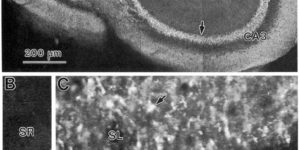Mossy fiber growth and synaptogenesis in rat hippocampal slices in vitro
Hippocampal slices from early postnatal rat were used to study mossy fiber (MF) growth and synaptogenesis. The ability of MFs to form new giant synapses within isolated tissue slices was established by a series of experiments involving synapsin I immunohistochemistry, electron microscopy, and whole-cell recordings. When hippocampal slices from immature rats were cultured for up to 2 weeks, the distribution of giant MF terminals was similar to that found in vivo. Using a lesioning procedure, we determined that MFs in slices extend and form appropriate synaptic connections with normal target CA3 pyramidal cells. MF terminals were dispersed more widely than normal within the CA3 pyramidal layer after a lesion, but electron microscopy indicated that synaptic junctions were still primarily associated with pyramidal cell dendrites and not the somata. Establishment of functional synaptic input in vitro was confirmed by whole-cell recordings of MF-driven excitatory postsynaptic currents (50 pA to 1 nA) in pyramidal cells. The results establish for the first time that an MF projection with appropriate and functional synaptic connections can be formed de novo and not just maintained in excised hippocampal slices. The cellular dynamics underlying MF growth and synaptogenesis were examined directly by time-lapse confocal imaging of fibers selectively stained with a fluorescent membrane dye (Dil or DiO). MFs growing deep within isolated tissue slices were tipped by small (5-10 microns), active growth cones that advanced at variable rates (5-25 microns/hr). Furthermore, dynamic filopodial structures were seen at small varicosities along the length of developing MFs, which may identify nascent en passant synaptic contacts. The hippocampal slice preparations are shown to support normal development of MF connections and allow for direct visualization of the cellular dynamics of synapse formation in a mammalian CNS tissue environment.
